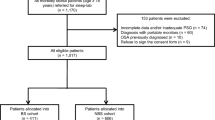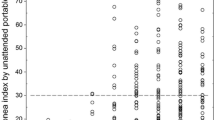Abstract
Background
No previous studies have validated the use of portable monitoring (PM) for the diagnosis of obstructive sleep apnea (OSA) in morbidly obese individuals. Our aim was to investigate the accuracy of PM for detecting respiratory events in morbidly obese patients that will be undergoing bariatric surgery.
Methods
This was a prospective study involving patients with body mass index (BMI) ≥35 kg/m2 who were recruited from the Sleep Clinic of Universidade Federal de São Paulo. Sleep-disordered breathing (SDB) was evaluated during full-night polysomnography (PSG). PM use was randomized and used on two consecutive nights: (1) at home (STDHome) and (2) at the sleep laboratory with PSG (PSG_STDLab).
Results
Although 58 participants initially underwent the recordings, 26 (45 %) were excluded because of technical problems. The patients’ mean age was 42.9 ± 10.9 (SD) years, and 56 % were female. The mean BMI was 40.8 ± 5.2 kg/m2. All patients had high risk for OSA, as defined by the Stop-Bang questionnaire, and the mean apnea-hypopnea index (AHI) was 46.9 ± 30.4/h. The intraclass coefficient of the correlation between AHI_PSG and AHI_STDLab was r = 0.92 (p = 0.0001); the intraclass coefficient for AHI_PSG and AHI_STDHome was r = 0.84 (p = 0.0001). The Kappa index was 0.87 (p > 0.0001) for severe cases. The sensitivity and the positive predictive value increased with the disease severity. A Bland-Altman analysis showed good agreement between the investigated methods.
Conclusions
PM is an efficacious method for diagnosing OSA in obese patients who have a high clinical probability of the disease. The method displays good sensitivity and specificity in severe cases; nevertheless, the high rate of data loss must be taken into account.


Similar content being viewed by others
References
Punjabi NM. The epidemiology of adult obstructive sleep apnea. Proc Am Thorac Soc. 2008;5(2):136–43. doi:10.1513/pats.200709-155MG.
Tufik S, Santos-Silva R, Taddei JA, et al. Obstructive sleep apnea syndrome in the Sao Paulo Epidemiologic Sleep Study. Sleep Med. 2010;11(5):441–6. doi:10.1016/j.sleep.2009.10.005.
Lesser DJ, Haddad GG, Bush RA, et al. The utility of a portable recording device for screening of obstructive sleep apnea in obese adolescents. J Clin Sleep Med. 2012;8(3):271–7. doi:10.5664/jcsm.1912.
Carneiro G, Florio RT, Zanella MT, et al. Is mandatory screening for obstructive sleep apnea with polysomnography in all severely obese patients indicated. Sleep Breath. 2012;16(1):163–8. doi:10.1007/s11325-010-0468-7.
Chai-Coetzer CL, Antic NA, Rowland LS, et al. Primary care vs specialist sleep center management of obstructive sleep apnea and daytime sleepiness and quality of life: a randomized trial. Jama. 2013;309(10):997–1004. doi:10.1001/jama.2013.1823.
Oliveira MG, Garbuio S, Treptow EC, et al. The use of portable monitoring for sleep apnea diagnosis in adults. Expert Rev Respir Med. 2014;8(1):123–32. doi:10.1586/17476348.2014.850421.
Chung F, Elsaid H. Screening for obstructive sleep apnea before surgery: why is it important. Curr Opin Anaesthesiol. 2009;22(3):405–11. doi:10.1097/ACO.0b013e32832a96e2.
Johns MW. A new method for measuring daytime sleepiness: the Epworth sleepiness scale. Sleep. 1991;14(6):540–5.
Hori T, Sugita Y, Koga E, et al. Sleep Computing Committee of the Japanese Society of Sleep Research Society. Proposed supplements and amendments to ’A Manual of StandardizedTerminology, Techniques and ScoringSystem for Sleep Stages of HumanSubjects’, the Rechtschaffen & Kales (1968) standard. Psychiatry Clin Neurosci. 2001;55(3):305–10.
Rahaghi F, Basner RC. Delayed diagnosis of obstructive sleep apnea: don’t ask don’t tell. Sleep Breath. 1999;3(4):119–24.
American Sleep Disorders Association. EEG arousals: scoring rules and examples: a preliminary report from the Sleep Disorders Atlas Task Force of the American Sleep Disorders Association. Sleep. 1992;15(2):173–84.
American Sleep Disorders Association Atlas Task Force. Recording and scoring leg movements. Sleep. 1993;16(8):748–59.
American Academy of Sleep Medicine Task Force. Sleep-related breathing disorders in adults: recommendations for syndrome definition and measurement techniques in clinical research. The Report of an American Academy of Sleep Medicine Task Force. Sleep. 1999;22(5):667–89.
Hulley SB et al. Designing clinical research: an epidemiological approach. Second Edition. Philadelphia: Lippincott Williams & Wilkins; 2001.
Santos-Silva R, Sartori DE, Truksinas V, et al. Validation of a portable monitoring system for the diagnosis of obstructive sleep apnea syndrome. Sleep. 2009;32(5):629–36.
White DP, Gibb TJ, Wall JM, et al. Assessment of accuracy and analysis time of a novel device to monitor sleep and breathing in the home. Sleep. 1995;18(2):115–26.
Polese JF, Santos-Silva R, Kobayashi RF, et al. Portable monitoring devices in the diagnosis of obstructive sleep apnea: current status, advantages, and limitations. J Bras Pneumol. 2010;36(4):498–505.
Oliveira MG, Nery LE, Santos-Silva R, et al. Is portable monitoring accurate in the diagnosis of obstructive sleep apnea syndrome in chronic pulmonary obstructive disease. Sleep Med. 2012;13(8):1033–8. doi:10.1016/j.sleep.2012.06.011.
Collop NA, Anderson WM, Boehlecke B, et al. Clinical guidelines for the use of unattended portable monitors in the diagnosis of obstructive sleep apnea in adult patients. Portable Monitoring Task Force of the American Academy of Sleep Medicine. J Clin Sleep Med. 2007;3(7):737–47.
Man GC, Kang BV. Validation of a portable sleep apnea monitoring device. Chest. 1995;108(2):388–93.
Yin M, Miyazaki S, Ishikawa K. Evaluation of type 3 portable monitoring in unattended home setting for suspected sleep apnea: factors that may affect its accuracy. Otolaryngol Head Neck Surg. 2006;134(2):204–9.
de Oliveira AC T, Martinez D, Vasconcelos LF, et al. Diagnosis of obstructive sleep apnea syndrome and its outcomes with home portable monitoring. Chest. 2009;135(2):330–6. doi:10.1378/chest.08–1859.
Acknowledgments
We would like to thank Laura Castro, MsC, and Altay Souza, PhD, for their valuable suggestions and statistical analyses.
Conflict of Interest
Márcia G. Oliveira, Erika C. Treptow, Cesar Fukuda, Luiz E. Nery, Rosana M. Valadares, Sérgio Tufik, Lia Bittencourt, and Sonia M. Togeiro had no conflict of interest.
Author information
Authors and Affiliations
Corresponding author
Rights and permissions
About this article
Cite this article
Oliveira, M.G., Treptow, E.C., Fukuda, C. et al. Diagnostic Accuracy of Home-Based Monitoring System in Morbidly Obese Patients with High Risk for Sleep Apnea. OBES SURG 25, 845–851 (2015). https://doi.org/10.1007/s11695-014-1469-6
Published:
Issue Date:
DOI: https://doi.org/10.1007/s11695-014-1469-6




